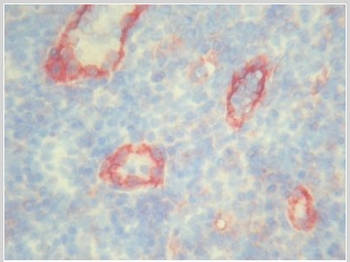CD31 (PECAM1) Mouse Monoclonal Antibody [Clone ID: MEM-05]
Specifications
| Product Data | |
| Clone Name | MEM-05 |
| Applications | FC, IHC |
| Recommended Dilution | Immunohistochemistry on Frozen Sections: 1-2 µg/ml (1/200-1/400). Immunohistochemistry on Paraffin Sections: 8 µg/ml (1/50). Proteinase K pretreatment for antigen retrieval is recommended. Suggested Positive Control: Human placenta. Has been described to work in FACS. |
| Reactivities | Human |
| Host | Mouse |
| Isotype | IgG1 |
| Clonality | Monoclonal |
| Immunogen | Human CD31 |
| Specificity | This antibody is specific for CD31. |
| Formulation | Stock solution contains PBS, pH 7.2 with 10 mg/ml BSA as a stabilizer and 0.09% Sodium Azide as a preservative. State: Lyophilized diluted ascites |
| Reconstitution Method | Restore by adding 0.5 ml distilled water to 0.4 mg/ml. |
| Storage | Store the lyophilized product at 2-8°C. Following reconstitution store in aliquots at -20°C. Avoid repeated freezing and thawing. |
| Stability | Shelf life: One year from despatch. |
| Gene Name | platelet and endothelial cell adhesion molecule 1 |
| Database Link | |
| Background | CD31, also known as platelet endothelial cell adhesion molecule 1 (PECAM1), is a type I integral membrane glycoprotein and a member of the immunoglobulin superfamily of cell surface receptors. It is constitutively expressed on the surface of endothelial cells, and concentrated at the junction between them. It is also weakly expressed on many peripheral lymphoid cells and platelets. CD31 has been used to measure angiogenesis in association with tumor recurrence. Other studies have also indicated that CD31 and CD34 can be used as markers for myeloid progenitor cells and recognize different subsets of myeloid leukemia infiltrates (granular sarcomas). The CD31 antigen is found on cells lining and within the vasculature, and plays a role in the adhesive interaction between adjacent endothelial cells as well as between leukocytes and endothelial cells. |
| Synonyms | PECAM-1, EndoCAM, GPIIA' |
| Note | Protocol: Protocol with frozen, ice-cold acetone-fixed sections: The whole procedure is performed at room temperature 1. Wash in PBS 2. Block endogenous peroxidase 3. Wash in PBS 4. Block with 10 % normal goat serum in PBS for 30 min. in a humid chamber 5. Incubate with primary antibody (dilution see datasheet) for 1h in a humid chamber 6. Wash in PBS 7. Incubate with secondary antibody (peroxidase-conjugated goat anti mouse IgG+IgM (H+L) minimal-cross reaction to human) for 1 h in a humid chamber 8. Wash in PBS 9. Incubate with AEC substrate (3-amino-9-ethylcarbazol) for 12 min. 10. Wash in PBS 11. Counterstain with Mayer's hemalum Protocol with formalin-fixed, paraffin-embedded sections: The whole procedure is performed at room temperature 1. Deparaffinize and rehydrate tissue section 2. Incubate the tissue section with proteinase K for 7 min. 3. Wash in distilled water 4. Block endogenous peroxidase 5. Wash in PBS 6. Block with 10 % normal goat serum in PBS for 30 min. in a humid chamber 7. Incubate with primary antibody (dilution see datasheet) for 1h in a humid chamber 8. Wash in PBS 9. Incubate with secondary antibody (peroxidase-conjugated goat anti mouse IgG+IgM (H+L) minimal-cross reaction to human) for 1 h in a humid chamber 10. Wash in PBS 11. Incubate with AEC substrate (3-amino-9-ethylcarbazol) for 12 min. 12. Wash in PBS 13. Counterstain with Mayer's hemalum |
| Reference Data | |
Documents
| Product Manuals |
| FAQs |
{0} Product Review(s)
0 Product Review(s)
Submit review
Be the first one to submit a review
Product Citations
*Delivery time may vary from web posted schedule. Occasional delays may occur due to unforeseen
complexities in the preparation of your product. International customers may expect an additional 1-2 weeks
in shipping.






























































































































































































































































 Germany
Germany
 Japan
Japan
 United Kingdom
United Kingdom
 China
China





